Ayurvedic Pharmacology – Charaka Samhita Sutrasthana 26
The 26th Chapter of Charaka Samhita explains Ayurvedic pharmacology in detail, along with incompatible foods, qualities and actions of taste, 5 basic elements. This chapter is called Atreya Bhadrakapyiya Adhyaya.
Once upon a time Atreya, Bhadrakapya, Shakunteya, Purnaksha Maudgalya, Hiranyaksha Kaushika, Kumarashira Bharadvaja, the king Varyovida, Nimi the king of Videha, Kankayana the best among the physicians of Bahlika (Balkh) – all these Ayurveda experts, having self control, assembled in the pleasant woods of Chaitraratha on a pleasant trip.
They sat together and then started discussing some of the vital problems relating to correlation between Rasa(taste) and Diet.[3-7]
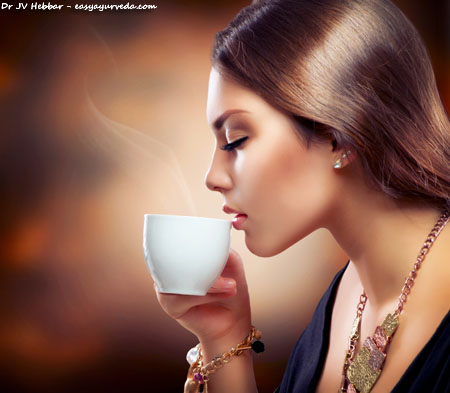
Table of Contents
Views on number of tastes
Different views of members on the number of taste (Rasa):
One type of taste
Bhadrakapya opined that there is only one type of taste. Because, taste is perceived by the tongue, and it is the object of the tongue sense organ. He said that it is no different than water element (Jala Mahabhuta)
Two types of tastes
Shakunteya Brahmana opined that there are two types of tastes:
Chedaneeya – Ematiationg, scraping
Upashamaneeya – Nourishing, palliating, calming
Three types of taste
Purnaksha Maudgalya – 3 types of taste
Chedaneeya – Ematiationg, scraping
Upashamaneeya – Nourishing, palliating, calming
Sadharana – In between Chedaneeya and Upashamaneeya
Four types of taste
Hiranyaksha Kaushika –
1. Swadu Hita – Palatable and wholesome
2. Swadu Ahita – Palatable but unwholesome
3. Aswadu Hita – Unpalatable, but wholesome
4. Aswadu Ahita – Unpalatable and unwholesome
Five types of taste
Kumarashira Bharadwaja – Five types
1.Parthiva – Originating from earth element
2. Apya – Originating from water element
3. Taijasa – Originating from fire element
4. Vayaviya – Originating from air element
5. Akashiya – Originating from ether / vacuum element
Six types of taste
Royal Sage Varyovida Six types
1. Guru (heavy)
2. Laghu (Light)
3. Sheeta (Cold)
4. Ushna (Hot)
5. Snigdha (Unctuous / oily)
6. Rooksha (Non unctouous)
Seven types of taste
As per Nimi the king of Videha –
1. Madhura (sweet)
2. Amla (sour)
3. Lavana (Saline)
4. Katu (Pungent)
5. Tikta (Bitter)
6. Kashaya (Astringent)
7. Kshara (Alkaline)
Eight types of tastes
As per Dhamaragava Badisa –
1. Madhura (sweet)
2. Amla (sour)
3. Lavana (Saline)
4. Katu (Pungent)
5. Tikta (Bitter)
6. Kashaya (Astringent)
7. Kshara (Alkaline)
8. Avyakta (imperceptible)
Infinite tastes
Kankayana Bahlika opines that tastes are innumerable, because of the innumerability of qualities, actions, that reside in a substance.[8]
Concluding Remarks
Concluding remarks by Chairperson- Lord Punarvasu:
There are only six tastes –
1. Madhura (sweet)
2. Amla (sour)
3. Lavana (Saline)
4. Katu (Pungent)
5. Tikta (Bitter)
6. Kashaya (Astringent)
The Yoni – source material for the manifestation of all these tastes is water element – Jala Mahabhuta
Chedana – emaciation and Upashamana – nourishment are two types of action of tastes. Hence they do not taste themselves. Combination of these two actions leads to the manifestation of tastes having a general action (Sadharana).
Swadu (Palatability) or otherwise is the subjective reaction (bhakti); wholesomeness (Hita) or unwholesomeness (Ahita) constitute the specific action; Hence, four types of tastes theory is invalid.
The five basic elements form dravya – substance. Due to different permutations and combinations, due to the effect of time, place, season on them, the substance exhibits qualities like Guru (heavy), laghu (lightness) etc. Hence six types of taste based on quality is invalid.
Because of its corrosive nature, it is known as Kshara / Alkali. Hence, it is a physical effect. Thus Kshara cannot be called as taste. This is manifested by the combination of many tastes and it possesses itself many tastes dominated by pungent and saline ones. Kshara is the object of many senses (for example, it can be seen, it can be touched etc) and it involves a special method of preparation.
Avyakta – imperceptibility of tastes is affected only in Jala Mahabhuta (water element). It happens when the taste is hidden deep in the substance or is exhibited incompletely. Hence, it cannot be said as a type of taste.
It is not correct to say that the tastes are innumerable, by just saying that the substances in the world are innumerable. Even in the innumerable substances, the qualities, action and taste of those substances are not innumerable. So we shall now explain the specific characteristics and distinctive features of the six tastes separately. [9]
Classification of Matter
Observations regarding the classification of matter:
All matter is constituted of five Mahabhutas (five basic elements);
Some of the materials are Chetana (have soul) and Achetana (does not have soul)
Qualities of substances are Shabda (sound), Sparsha (touch), Roopa (vision), Rasa (taste) and Gandha (Smell) .Also the twenty qualities beginning with heaviness etc .
These substances are useful in Vamana etc Panchakarma therapies.[10]

Physical properties of Pancha Mahabhutas
Earth Element
Qualities and function of earth element –
Substances that have below qualities in abundance are called as Parthiva – having earth as dominant element.
Guru – heavy,
Khara – tough,
Katina – hard,
Manda – dull,
Sthira – stable,
Vishada – non-slimy, clear
Sandra – dense,
Sthoola – bulk, gross and
Gandha – Smell
These Parthiva – earth dominant substances cause
Upachaya – promote plumpness,
Sanghata – compactness, give shape to body and body organs
Gaurava – heaviness and
Sthairya – stability.
Water Element
Qualities and function of (liquids) materials having water-element dominance – Apya Dravya
Substances that have below qualities in abundance are called Apya – having water as the dominant element.
Drava – liquid
Snigdha – unctuous, oily
Sheeta – cold
Manda – dull, slow flowing
Mrudu – soft
Picchila – slimy, sticky
Rasa – taste
They promote below functions
Upakleda – stickiness,
Sneha – unctuousness, Oiliness,
Bandha – compactness,
Vishyanda – moistness,
Mardava – softness and
Prahlada – happiness.
Fire element
Qualities and function of materials having fire-element dominance – Agneya Dravya
Substances that have below qualities in abundance are called Agneya – having fire as the dominant element.
Ushna – hot,
Teekshna – sharp,
Sookshma – subtle, minute
Laghu – light,
Rooksha – dryness
Vishada – non-slimy, clarity
Roopa – vision
They promote below functions
Daaha – combustion, burning
Paaka – digestion, metabolism,
Prabha – lustre,
Prakasha – radiance
Varna – color.
Air element
Qualities and function of materials having air-element dominance – Vayavya Dravya
Substances that have below qualities in abundance are called as Vayavya – having air as the dominant element.
Laghu – lightness,
Sheeta – cold,
Rooksha – non unctuous, dry
Khara – rough,
Vishada – Clear, non- slimy,
Sookshma – subtle, minute
Sparsha – touch
They promote
Roukshya – roughness,
Glani – aversion, tiredness
Vichara – movement,
Vaishadya – clarity, non-sliminess and
Laghava – lightness.
Ether Element
Qualities and function of materials having ether / vacuum – element dominance – Akasheeya Dravya
Substances that have below qualities in abundance are called as Akasheeya – having ether as dominant element.
Mridu – soft,
Laghu – lightness,
Sookshma – smoothness
Shabda – sound
They promote
Mardava – softness,
Soushirya – porosity, emptiness and
Laghava – lightness.[11]
All substances as medicine
All the substances in this world can be medicine:
With the above explanation, there are no substances in this world, without any medicinal qualities / therapeutic utility. It is up to the physician to appropriately choose and use the substances as medicine based on
Yukti – planned wisdom
Artha – knowledge of the exact purpose of the substance. [12]
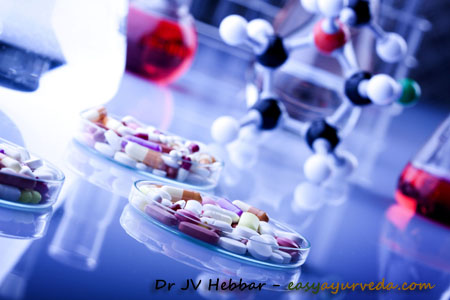
Action of Medicine
How does medicine act? Pharmaco-dynamics of drugs:
It is not just by the virtue of Guna – qualities, that a substance exhibits action.
In fact they act by virtue of their own nature or qualities or both on a proper occasion, in a given location, in appropriate condition and situations; the effect so produced is considered to be their action( Karma).
Yena Kurvanti, tat veeryam – By which a medicine acts, is called as Veerya. The factor responsible for the manifestation of the effect is known as Veerya.
Yatra kurvanti tat adhikaranam – where they act is the Adhisthana / Adhikarana ( site of action);
Yada kurvanti, sa kaalaha – when they act is the time,
yathaa kurvanti sa upaayaha – how they act is the Upaya or mode of action.
Yat sadhayati, tat phalam – what they accomplish is the achievement.[13]
Taste combinations
There are 63 combinations of Rasas (tastes) depending upon the variation of the nature of the substance, location and time, they are being explained here.[14]
Sixty three types of Rasa:
A. By the combination of two Rasas-15 in number
1. Sweet and sour
2. Sweet and saline
3. Sweet and pungent
4. Sweet and bitter
5. Sweet and astringent
6. sour and saline
7. sour and pungent
8. sour and bitter
9. sour and astringent
10. saline and pungent
11. saline and bitter
12. saline and astringent
13. pungent and bitter
14. pungent and astringent
15. bitter and astringent
B. By the combination of three Rasas- 20 in number
16. Sweet , Sour and Saline
17. Sweet , Sour and Pungent
18. Sweet Sour and bitter
19. Sweet, Sour and Astringent
20. Sweet, saline and Pungent
21. Sweet, Saline and Bitter
22. Sweet , saline and Astringent
23. Sweet, Pungent and bitter
24. Sweet, Pungent and Astringent
25. Sweet, bitter and Astringent
26. Sour, Saline and Pungent
27. Sour, saline and Bitter
28. Sour , Saline and astringent
29. Sour, Pungent and Bitter
30. Sour, Pungent and Astringent
31. Sour, Bitter and Astringent
32. Saline, Pungent and Bitter
33. Saline, Pungent and Astringent
34. Saline, Bitter and Astringent
35. Pungent, Bitter and Astringent
C. By the combination of four Rasas-15 in number
36. Sweet, Sour , Saline and Pungent
37. Sweet, Sour , Saline and Bitter
38. Sweet, Sour , Saline and Astringent
39. Sweet, Sour , Pungent and Bitter
40. Sweet, Sour , Pungent and Astringent
41. Sweet, Sour , Bitter and Astringent
42. Sweet, Saline, Pungent and Bitter
43. Sweet, Saline, Bitter and Astringent
44. Sweet, saline, Astringent and Pungent
45. Sweet, Pungent, bitter and Astringent
46. Sour, Saline, Pungent and Bitter
47. Sour, Saline, Bitter and Astringent
48. Sour, Saline, Astringent and Pungent
49. Sour, Pungent, Bitter and Astringent
50. Saline, Pungent, Bitter and Astringent
D. By the combination of five Rasas- 6 in number
51. Sour, Saline, Pungent Bitter and Astringent
52. Sweet, Saline, Pungent, Bitter and Astringent
53. Sweet, Sour, Pungent, Bitter and Astringent
54. Sweet, Sour, Saline, Bitter and Astringent
55. Sweet, Sour, Saline, Pungent and Astringent
56. Sweet, Sour, Saline, Pungent and Bitter
E. Without any combination -6 in number
57. Sweet
58. Sour
59. Saline
60. Pungent
61. Bitter
62. Astringent
F. By the combination of all the Six Rasas-
63. Sweet, Sour, Saline, Pungent, Bitter and Astringent. [15-22]
The number may still go up to the extent of infinity if Anurasa (after tastes or subsidiary tastes) and their relative degrees are taken into account. [23]
In view of their therapeutic utility, fifty- seven combinations and sixty three types of Rasas(tastes) are enunciated.[24]
General principles of Rasa therapy:
A physician may prescribe drugs having one taste or combination of several tastes, with due regard to the nature of imbalanced Doshas, the resultant manifestation of the disease and specific actions of drugs etc, for the maintenance of health. Similarly for the cure of diseases, drugs having one or more tastes may be prescribed.[25-26]
Importance of the knowledge of the classification of Rasa and Dosha:
A physician, well acquainted with the combinations of Rasa (taste) and Doshas, seldom commits blunders in ascertaining the aetiology, symptoms and treatment of diseases. [27]
Identification of Rasa (taste) and Anurasa (after-taste)in a given substance:
The taste that is felt at the beginning and end of the time of contact of tongue, by a dry substance, is considered as Rasa. When such a taste is not distinctly perceptible but is inferred only by its actions, it is known as Anurasa (after-taste). It is included in one of the six tastes and there is no separate seventh taste.[28]
Paradi Guna – Special list of qualities:
Apart from the 20 qualities of substances, there are 10 other qualities, known as Paradi Guna (starting from Para). They are –
Para – superiority
Apara – inferiority
Yukti – planning, propriety (proper application),
Sankhya – number
Samyoga – combination
Vibhaga – division
Pruthaktva – individuality, separation (consisting of non combination, distinctness and plurality),
Parimana – quantification
Samskara – habit, transformation (method of preparation)
Abhyasa – practice, repetition
Para, Apara (superiority and inferiority)
The superiority and inferiority can be appreciated in
Desha – place, parts of body
Kala – season
Vayo – age
Mana – measurements
Paka – digestion
Veerya – potency
Rasa – taste
Yukti – planning:
Planning of treatment with one or more components.
Sankhya – number:
Sankhya is related with maths, to counting.
Samyoga – combination:
Samyoga is combining two or more substances.
Vibhaga – division:
Division of a complex thing into many components is Vibhaga
Prutaktva:
Prutaktva is individuality, considering each component singularly, differentiation.
Parimana:
To measure or quantify.
Samskara:
Processing, converting, habit, transformation (method of preparation)
Abhyasa –
Doing the same thing continuously.
Without knowing these Paradi qualities, a physician cannot do well in treatment. [29-35]
Properties attributed to Rasas really belong to Dravyas:
A quality, itself cannot hold another quality. So, taste, being a quality, cannot hold other qualities. All the qualities of the taste that were explained, are actually the qualities of the substance, which holds that taste.
All the qualities including taste, reside in the substance (Dravya). [36]
In the event of the texts conveying apparently conflicting views, the interpretation should be based on the contextual, local and temporal propriety, the intention of the author and the rules of interpretation (Tantra Yukti).[37]
Genesis of Rasa from five basic elements;
The moon is the presiding Deity of water. The water in the atmosphere (before it falls on the ground) is by nature cold and light, and its Rasa is not manifested at this stage. The moment it starts falling from the atmosphere and after it falls on the ground, it gets impregnated with the qualities of the five Mahabhutas and it nourishes the individuals belonging to the vegetable and animal kingdom. At this stage the six tastes manifest themselves in these individuals. [39]
Predominance of basic elements in individual Rasa:
All the tastes have Jala Mahabhuta (water element) dominance.
Sweet taste – Madhura rasa = Prithvi + Ap (earth + water)
Sour taste – Amla rasa = Prathvi + Agni (earth + fire)
Salt taste – Lavana Rasa = Jala and Agni (water + fire)
Pungent taste – Katu Rasa = Vayu + Agni (air and fire)
Bitter taste – Tikta Rasa = Vayu + Akasha (air and ether)
Astringent taste – Kashaya Rasa = Vayu and Prithvi (air and earth).
Vegetables and animals are of diverse types, depending upon their color and shape (owing to the predominance or otherwise of the various Mahabhutas (5 basic elements)). Similarly, tastes are also six in number due to the predominance or otherwise of the five Mahabhutas. The predominance or otherwise of five Mahabhutas in turn depends on the six seasonal variations. [40]
Flow of Rasas (taste):
Rasas with qualities of fire (Agni) and air(Vayu) have a tendency of upward movement. This is because of the lightness and upward mobility of Vayu and upward flames of Agni.
The Rasas with the qualities of Jala and Prithvi on the other hand have a tendency for downward movement because of the heaviness of Prithvi and downward flow of Jala.
The Rasas within both the categories of substances mentioned above share both the qualities. [41]
We shall now explain the properties and actions of each one of the six Rasa as they are found in various drugs and diets. [42]
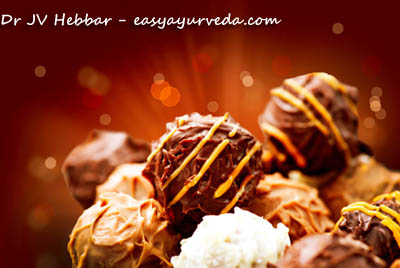
Action of Sweet Taste:
Shareera Satmya – congenial to the body, wholesome
Rasa, Rudhira, Mamsa Medo Asthi Majja Oja Shukra Abhivardhana – improves – Rasa(body fluid), blood, muscle, fat, bone, marrow, ojas, semen and longevity and also Ojas.
Ayushyaha – improves life expectancy.
Shadindriya Prasadana – They are soothing to the six sense organs. (5 + mind)
Bala Varnakara – improves strength and skin complexion
Pitta Visha Marutaghna – balances Pitta, toxicity and Vata.
Trishna Daha Prashamana – relieves thirst and burning sensation
Tvachya – improves skin quality
Keshya – improves hair
Kanthya – improves voice quality
Balya – improves strength and immunity
Preenana – soothing
Jeevana – enlivening,
Tarpana – invigorating
Brihmana – nourishing
Sthairyakara – improves body stamina and stability
Ksheena Kshata Sandhanakara – useful in relieving chest injury and bone fracture healing
Ghrana Mukha Kantha Oshta Jihva Prahladana – soothing to the nose, mouth, throat, lips and tongue
Daha Murcha Prashamana – relieves burning sensation and unconsciousness
Shat Pada Pipeelikaanaam ishtatamaha – attracts bees and ants.
Snigdha sheeto guruscha – unctuous, coolant and heavy to digestion
When sweet is used in excess, it causes Kapha vitiation, leading to
Sthoulya – obesity
Mardava – increased softness of the body
Alasyam Atisvapnam – increases laziness, and excess sleep,
Gauravam – increased feeling of heaviness
Ananna Abhilasha – lack of interest in food
Agner Daurbalya – low digestion strength
Aasya Kanthayor maamsaabhivruddhi – increased muscle growth in mouth and throat
Shwasa, Kasa – cough, cold, asthma, running nose, indigestion (intestinal torpor)
Sheeta jwara – fever of Kapha imbalance, with cold feeling
Anaha – bloating
feeling of sweetness in mouth
Vamathu – vomiting
loss of sensation, loss of voice
Galaganda, Gandamala, Shleepada – Scrofula, cervical lymphadenitis, elephantiasis,
Gala Shopha – Galasopha (Pharyngitis)
Bati Dhamani Galopalepa – Adhesion in the bladder, vessels (as in atherosclerosis – cholesterol deposition in blood vessels), throat
Akshi Amaya, Abhishyanda – eye disorders, conjunctivitis [43-i]
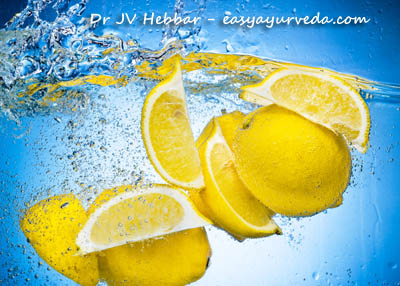
Action of Sour Taste – Amla Rasa
Bhaktam rochayati – improves taste of food
Agnim deepayati – improves digestion strength
Deham brimhayati, Urjayati – nourishes the body, improves enthusiasm
Mano Bodhayati – pleases the mind
Indriyani Drudhikaroti – strengthens sense organs
Balam Vardhayati – improves strength and immunity
Vatam Anulomayati – ensures movement of Vata in its natural direction
Hrudayam tarpayati – nourish the heart
Asyam Asravayati – causes salivation
Bhuktam Apakarshayati – helps in swallowing
Kledayati, jarayati – moistens and digests food
Preenayati – refreshing
Laghu, Ushna Snigdhascha – light, hot and unctuous
When sour is used in excess, it leads to
Dantan harshayati – causes tingling sensation in teeth
Tarshayati – causes excessive thirst
Sammeelayati akshini – causes drowsiness in eyes
Samvejayati lomani – horripulation
Kapham vilapayati – Liquefies and vitiated Kapha
Pittam Abivardhayati – increases Pitta
Raktam dushayati – vitiates blood
Mamsam vidahati – causes burning sensation in muscle tissue
Kayam shithilikaroti – makes the body brittle
ksheenakshata krusha durbalaanaam shvayathum aapadayati – in lean, injured and weak persons, it causes swelling and inflammation
Due to heating properties they cause suppuration of wounds caused by ulceration, trauma, contagious bites, burn, fracture, animals, (viz snakes like Karanda), bruise, excision, incision, separation, perforation and crushing.
paridahati kantamuro hrudayam ca – Causes burning sensation in throat and heart region. [43-ii]
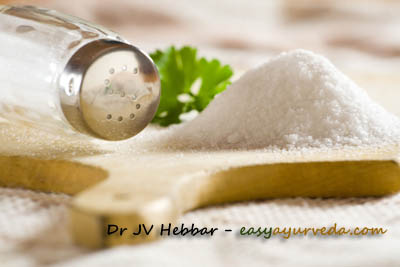
Action of Salt taste – Lavana Rasa Karma –
Pachanaha – help in digestion
Kledanaha – causes moistening effect
Deepanaha chyavana chedano -improves digestion, scraping effect, excision effect
bhedana, teekshna – breaks down, piercing, sharp
Saro – causes / initiates movement
Vikaarasya adhaha sramsyavakaashakara – causes movement of Doshas in downward direction
Vatahara – Balances Vata
Stambhana bandha samghata vidhamana – breaks down stiffness, tightening effect and obstructions
sarvarasa pratyaneekabhutaha – can dominate all other tastes
aasyam aasraavayati – causes salivation
kapham vishyandayati – liquifies Kapha
maargaan vishodhayati – cleanses and clears body channels
sarvashareera avayavaan mrudukaroti – softens and brings about tenderness in all body parts
rochayati aahaaram – improves taste of food
aahaarayogi naatyartham guru snigdha ushnascha – essential ingredient in foods. It is not too heavy, not too hot and not oily.
When salt is used in excess –
Pittam kopayati – causes vitiation of Pitta
Rakatm vardhayati – aggravates blood
Tarshayati – causes excessive thirst
Murchayati – causes fainting
Tapayati – causing heating sensation
Darayati – causes erosion
Krushnati mamsani – depletion of muscle tissue
Pragalayati kushtani – sloughing of skin diseases
Visham vardhayati – aggravates poison effects and symptoms
shophan sphotayati – opens up swellings
dantan chyavayati – causes teeth dislodgement
pumstvam upahanti – causes impotency
indriyani uparunaddhi – obstruction of the function of senses
vali palita khalityam apadayati – premature wrinkling, graying and baldness
lohitaptta amlapitta – bleeding disorders, gastritis
visarpa – herpes
Vatarakta – gout
Vicharchika indralupta – eczema and alopecia [43-iii]
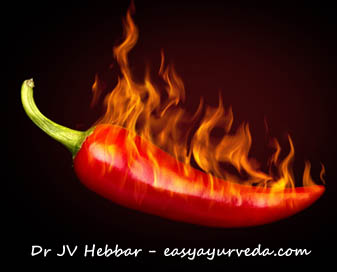
Action of Pungent Taste – Katu Rasa
Vaktram Shodhayati – cleanses mouth
Agnim deepayati – improves digestion strength
Bhuktam shoshayati – dries up food
Ghranam asravayati – causes watering of nose
Chakshur virechayati – causes lacrimation
Sphutikaroti indriyani – sharpens sense organs
cure diseases like Alasaka (intestinal toper), Shvayathu (inflammation), Upachaya (obesity), Udarda (urticaria), Abhishyanda (chronic conjunctivitis),
Sneha Sveda Kleda malan upahanti – helps in oleation, sweating, helps in elimination of sticky waste products
Rochyayati Ashanam – improves food taste
Kandur vinashayati – relieves itching
Vranan avasadayati – allay excessive growth of ulcers
Krimeen Hinasti – kills germs and worms
Mamsam vilikhati – scrapes down muscle tissue
Shonita Sanghatam bhinatti – breaks down blood clots
Bandhan chinatti – breaks down bonding,
Margan Vivrunoti – clears body channels
Shleshmanam shamayati – balances down Kapha
Laghu, Ushna, Rooksha – light, hot and dry in nature.
Effect of excess of pungent taste –
Pumstvam Apahanti – causes impotence
Glapayati, Sadayati, Karshayati – cause unconsciousness, weariness, leanness
Murchayati – causes unconsciousness
Namayati – causes body to bend forward
Tamayati – causes feeling of darkness
Bhramayati – causes dizziness
Kantam Paridahati – burning sensation in throat
Shareera tapam upajanayati – burning sensation in body
Balam kshinoti – depletes strength and immunity
Trushnam janayati – causes thirst
Because of the dominance of Vayu and Agni mahabhutas they also cause dizziness (bhrama), burning sensation (Davatu), tremor (kampa) piercing (toda) and stabbing pain (bheda) in legs, hands, back etc. [43-iv]
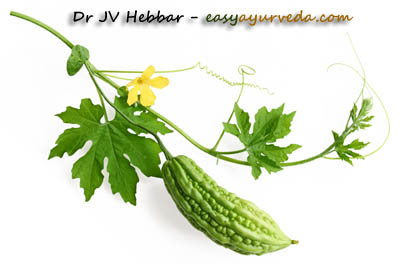
Action of Bitter Taste – Tikta Rasa
Though not so good to taste, when taken, it improves taste in the person.
Vishaghna detoxifies:
krimighna – kills germs and worms
Murcha daha kandu kushta – relieves unconsciousness, burning sensation, itching and skin disorders
relieves thirst, strengthens and stabilizes body
Jvaraghna, Deepana, pachana – useful in fever, digestive and carminative
Stanya shodhana – cleanses, purifies breast milk
Lekhana – scraping
dries up excess moisture, fat, marrow, lymph, pus, sweating, urine, Pitta and Shleshma.
Rooksha, Sheeta Laghu – dry, cold and light
Excess of Bitter taste causes –
Due to dryness, roughness, non sliminess, bitter depletes Rasa dhatu (essence part of digestion), blood (rudhira), Mamsa (muscle tissue), Meda (fat tissue), Asthi (bone), Majja (marrow), Shukra (semen, female reproductive system).
Srotasam kharatvam upapadayati – brings about roughness to the body channels
depletes strength and immunity
Karshayati – depletes body weight
Glapayati -weariness
Mohayati – unconsciousness
Bhramayati – giddiness
Vadanam upashoshayati -dryness of mouth
Vata Vikara anupajanayati -causes diseases of Vata imbalance [43-v]
Action of Astringent Taste – Kashaya rasa –
Samshamana – calming, healing
Sangrahi – absorbing, constipative
Sandhanakara – wound healing, bone healing
Peedana – causes pressure on body parts
Ropana – healing
Shoshana – dries up moisture
Stambhana – blocking
Shleshma raktapitta prashamana – balances down Kapha and Pitta, useful in bleeding disorders,
Shareera Kleda Upayokta – uses up body moisture
Rooksha, Sheeta, Laghu – dry, cold and light
Excess of astringent taste causes
Asyam shoshayati – dries up mouth
Hrudayam Peedayati – causes pressure pain in chest, heart
Udaram adhmapayati – distention of abdomen
Vacham nigruhnati – obstruction of speech
Srotamsi avabadhnati – constriction of channels
Shyavatvam apadayati – imparts black complexion
Pumstvam upahanti – causes impotency
Vishtabhya jaram gacchati – they get stuck in the gut and undergo digestion slowly
causes obstruction to the passage of flatus, urine, stool and semen
Karshayati – causes emaciation
Glapayti – weariness
Tarshayati – excess thirst
Stambhayati – causes stiffness
Due to roughness, dryness and non-sliminess astringent taste produces diseases like hemiplegia (pakshavadha), spasm (graha), convulsion(Apatanaka), facial paralysis (Ardita) etc, due to the vitiation of Vata.[43]
All the six Rasas, if properly used jointly or individually, in the proper dose, bring about happiness to all living beings. Otherwise they are equally harmful to all. So a wise person should use them properly in the proper dose in order to have good results. [44]
Determination of potency (Veerya) of a substance based on Rasa (taste):
The medicines and diet which are sweet in rasa and Vipaka (taste after digestion) are of Sheeta Veerya (cold potency). Those with sour or pungent taste and Vipaka are of Ushna Veerya (hot potency).[45]
For example: Milk and ghee, with sweet taste and sweet Vipaka, have sheeta Veerya (cold potency). Chavya (piper chaba Hunter) and chitraka (lead wort) are pungent in taste, pungent Vipaka, and have ushna veerya (hot potency)[46-47]
Substances whose Veeryas (potency) are contradictory to Rasa (taste):
Some substances having a sweet taste are of Ushna Veerya (hot) e.g the meat of aquatic and marshy animals – Anupa and Abja mamsa.
Some substances having astringent and bitter tastes are also of Ushnavirya (hot) e.g belonging to Mahat Panchamula (Agnimantha, Shynoaka, Gambhari and Patala), Arka – Calotropis Gigantea R.Br), Aguru ( Aquilaria agallocha Roxb.) and Guduchi –all these have bitter taste. Similarly rock salt having saline taste has Ushna Veerya (hot) Amalaka (Emblica officinal’s Gaertn) having sour taste has Anushna Virya (not hot).[48-49]
Variation in the action of substances of similar tastes:
Some herbs having sour taste are absorbent – e.g. Kapittha (Feronia limonia swingle);
Some sour herbs are laxative, e.g Amalaka (Emblica officinalis Gaertn).
Even though herbs having pungent taste are generally non-aphrodisiac, still Pippali ( Piper longum Linn) and Shunti (Zingiber officinale Rosc) having such taste are aphrodisiac.
Astringent herbs are usually Sheeta Veerya and absorbent, but Haritaki ( Terminalia chebula Linn) is an exception to it – it is Ushnavirya and laxative.
Thus it is not possible to explain the properties of all the drugs and diets simply in terms of Rasa because individual drugs having identical tastes vary in relation to their properties. [50-52]
Relative superiority of Tastes based on certain qualities:
For Dryness quality (Rooksha), Kashaya (astringent) is best, Katu (pungent) is medium and Tikta (bitter) is inferior.
For hotness quality (Ushna) – lavana (salt) is superior, sour is medium and Katu (pungent) is inferior.
For Unctuousness, oiliness (Snigdha) quality, Sweet is superior, Pungent is medium and Bitter is inferior
For Cooling quality (sheeta), Sweet – Astringent – Bitter
For Heaviness (guru) – Sweet- Astringent – salt
For lightness (laghu) – bitter – Pungent – Sour
Some authors are of the view that among light drugs and diets, those having saline taste are inferior. Thus drugs and diets having saline taste are inferior both in heaviness and lightness. [53-56]
The Vipaka of Substances:
Vipaka (taste after digestion) of substances having pungent, bitter and Astringent tastes is pungent (Katu Vipaka). Sour taste has Sour Vipaka (Amla Vipaka). Sweet and salty tastes have Sweet (Madhura Vipaka) . [57-58]
Role of tastes in evacuation of faeces:
Owing to their unctuousness (oiliness), sweet, sour and saline tastes are useful for the elimination of flatus, urine and stool.
On the other hand, pungent, bitter and astringent tastes create difficulty in the elimination of flatus, stool, urine and semen in view of their drying property. [59-60]
Action of Vipaka on Dosha and Evacuation:
Katu Vipaka (pungent) aggravates Vata, reduces semen and obstructs the passage of stool and urine.
Madhura (Sweet) Vipaka aggravates Kapha, promotes semen and helps in the proper elimination of stool and urine.
Similarly (sour) Amla Vipaka aggravates Pitta, reduces semen and helps in the proper elimination of stool and urine.
Sweet Vipaka is heavy, pungent and sour ones are light. [61-6]
The relative superiority or inferiority of various types of Vipaka can be determined on the basis of the relative superiority and inferiority of the various properties of different drugs and diets.[63]
The eight and the Two types of Veerya:
Some opine there are eight types of Veerya –
Mridu (mild) X Teekshna (sharp),
Guru (heavy) X Laghu (light)
Snigdha (unctuous) X Rooksha (dry)
Ushna (hot) X Sheeta (cold).
Some others hold the view that it is only of two types viz, Sheeta Veerya – Cold potency and Ushna Veerya (hot). The term potency (Veerya) represents that aspect of drugs and diets by virtue of which they manifest their therapeutic action . There cannot be any action without potency; all actions are caused by potency (Veerya).[64-65]
Determination of Rasa, Vipaka and Virya:
Rasa or taste can be ascertained immediately after their contact with the tongue. Vipaka is determined by the action (in the form of aggravation of Kapha etc). Virya can be determined in between the stages of Rasa and Vipaka, while in association with the body and or even immediately after coming into contact with the body.[66]
Definition of Prabhava:
Where there is similarity in two drugs in relation to their Rasa (taste), Vipaka and Virya (Potency) but in spite of this similarity these two drugs differ with regard to their action, the distinctive feature responsible for their distinctive effects not supported by their taste, Vipaka and potency is regarded as ‘ Prabhava’ or Specific action.[67]
Examples of Prabhava and the supremacy of Prabhava:
Both Chitraka – Leadwort – Plumbago zeylanica and Danti (Baliospermum montanum) are pungent in Pungent Vipaka and Ushna veerya (hot potency). But Danti acts as a purgative while chitraka does not. The purgative effect of Danti, therefore, can be explained only by taking recourse to its Prabhava or specific action.
The anti- toxic properties of toxins, actions leading to the upward and or downward elimination of Doshas (Vamana, Virechana) and various effects of precious noble stones (Mani) when worn over the body are all these are due to their specific actions which are beyond all plausible explanations. Hence, they are said to act because of their Prabhava – special action.
Ayurvedic Pharmacology – How a medicine acts?
Certain drugs manifest their action by virtue of their taste.
Some by virtue of their potency (Veerya)
Some act by the virtue of Guna (quality) or Vipaka (taste conversion after digestion).
Some acts by Prabhava (specific action).
In case the taste (Rasa), Vipaka, Veerya and Prabhava are all of equal strength, by nature,
taste is superseded by Vipaka, both of them in turn are superseded by potency.
All the above are dominated by Prabhava – special action. [68-72]
Characteristics of the Six Tastes:
Characteristic features of sweet taste –
Sweetness is ascertained from
Snehana – oiliness, unctuousness,
Preenana – deliciousness,
Ahlada – delightfulness
Mardava – softness.
When taken in, it pervades all over the mouth as it is adhering to the mouth.
Characteristc features of Sour taste:
Sourness is ascertained from
Dantaharsha – tingling sensation in teeth
Mukha srava – Salivation,
Svedana – Sweating,
Mukha Bodhana – Clarity of mouth
Vidaha – burning sensation in the mouth and throat.
Characteristic features of salt taste –
Salt gets quickly dissolved in the mouth resulting in stickiness (kleda),
Vishyanda – moistness
Mardava – softness
Mukhasya Vidaha – produce burning sensation in the mouth.
Characteristic features of pungent taste:
Pungent taste is ascertained by-
irritation and pain in tongue, burning and watering in the mouth, nose and eyes.
Characteristic features of bitter taste:
Bitter taste is ascertained by – weakening of taste perception of the tongue.
Such substances by themselves are not tasteful.
Causes non-sliminess, clarity (Vaishadya)
Shosha – dryness of tongue and
Prahlada – delightness.
Characteristc features of astringent taste:
Astringent taste is characterized by
Vaishadya – non-sliminess,
Stambha – stiffness,
Jadya – inaction in the tongue and
Badhnateeva Kantham – obstruct the throat as it were, they are not good for the heart. [73-79]
Agnivesha’s question on unwholesome medicine and diets:
After Lord Atreya explained the above theory, Agnivesha inquired, “Oh! Lord, we have listened to what you have stated about the medicines and diets, their properties and actions together with all relevant details. We would like to know in detail about the unwholesome properties of certain diets (that is alone which cause vitiation of the Dhatus (body tissues)”[80]
Lord Atreya’s reply – Incompatible combinations
The substances that are unwholesome to the body tissues and Doshas, oppose the body tissues.
1. Kanichit Paraspara guna viruddhani – Some act against the health, due to their mutually contradictory qualities.
2. Kanichit Samyogat – Some act against health, by the combination of two (though, as individual substances, they may not be opposite to each other in qualities).
3. Samskarat – Some by the method of preparation;
4. Desha Kala Matradibhihi – Some by virtue of the place (land and body), time and dose and
5. Svabhavat – Some others by their inherent) nature.[81]
Examples:
Milk with fish –
Fish should not be taken together with milk, both of them have sweet taste, but due to the contradiction in their potency (fish is hot and milk is cold) they vitiate the blood and obstruct the channels of circulation
Having listened to Lord Atreya, Bharadvaja said to Agnivesha, “One can take all kinds of fish except Chilichima together with milk. The Chilichima fish has scales; its eyes are red and it has red spots all over the body, it is like the Rohita (red carp fish) fish and moves on the ground. If this fish is taken with milk, it is bound to cause constipation and diseases relating to blood and it may even cause death”.[82-83]
Lord Atreya while disagreeing with the above view said, “One must not take milk along with fish especially with Cilicima type of fish. Cilicima fish considerably obstructs the channels of circulation and causes the above-mentioned diseases whose symptoms are very clear. It also produces Amavisa (toxin due to improper digestion as well as metabolism).
Meat combinations – Meat of domestic, marshy and aquatic animals (Gramya, Anupa Audaka Pishita) should not be taken together with honey, sesame seeds, sugar candy, milk, black gram (Masha), radish, lotus stalk or germinated grains (Viruda dhanya). By doing so, one gets afflicted with deafness, blindness, trembling, loss of intelligence, loss of voice and nasal voice, it may even cause death.
One should not taken vegetable of Pushkara (Nelumbo Nucifera Gaertn) and Katukarohini – Picrorhiza kurroa or meat of Kapota (dove) fried in mustard oil together with honey and milk, for this obstructs channels of circulation and causes dilatation of blood vessels, epilepsy, Shankhaka (a disease of the head characterized by acute pain in temporal region), Galaganda (Scrofula) or even death.
Milk combinations – Milk should not be taken after the intake of radish, garlic, Keshnagandha (Moringa oleifera Lam.) Arjaka ( Ocimum gratissimum Linn), Sumukha Surasa (Tulsi – Holy basil) etc. may cause skin diseases.
Leaves of Jatuka(Ferula narthex) or ripe fruit of Nikucha (Artocarpus lakoocha Roxb). Should not be taken with honey and milk, it may cause loss of strength complexion, and semen, sterility and other serious types of diseases which may lead to death.
Ripe fruit of Nikucha (Artocarpus lakoocha Roxb) should not be taken with the soup of Masha (black gram), sugar candy and ghee because they are mutually contradictory.
Milk with sour fruits – Amra – mango, Amrataka – Spondias pinnata Kurz, Matulunga – Lemon variety (Citrus decumana / Citrus limon Linn), Nikucha (Artocarpus Lakoocha Roxb), Karamarda (Carisa Karandas Linn), Mocha( Salmalia malabarica Schett & Endl), Dantashatha (Citrus medica Linn), Badara – Zizyphus jujuba, Koshamra Bhavya(Dillenia indica Linn), Jambava (Syzygium cumini Skeels), Kapittha (Feronia limonia), Tintidi (Tamarindus indica Linn), meat of Paravata (Pigeon), Akshoda ( Juglans regia Linn), Panasa (Jackfruit), Narikela (Coconut), Dadima – Pomegranate, Amalaka (Emblica officinalis Gaertn) and such other solid and liquid materials which are sour in taste become mutually contradictory when taken with milk.
Similarly Kangu (Setaria italica Beauv), Vanaka Makustha (Phaseolus aconitifolius Jacq), Kulattha (Horse gram), Masha (black gram) Nishpava (pea), when taken with milk are mutually contradictory.
Padma (Nelumbo Nucifera Gaertn); Leaves of Uttarika, Sharkara type of wine, Maireya type of wine and honey, if taken together are unwholesome and they aggravate, Doshas specially Vata.
Meat of Haritala bird fried with mustard oil is unwholesome and they aggravate Dohsas, especially Pitta.
Payasa (milk preparation) when taken with Mantha (thin gruel) is unwholesome and they aggravate Doshas, especially Kapha.
Upodika (Basella rubra Linn), prepared with the paste of Tila (Sesame seed) causes diarrhoea.
Meat of a crane either with Varuni type of wine or Kulmasha (Paste of Barley mixed up with hot water and slightly boiled so as to form a cake) is unwholesome; again if fired with lard, it will cause instantaneous death.
Meat of peacock roasted on a castor spit, if burnt with castor wood fuel and mixed with castor oil causes instantaneous death. Similarly the meat of Haaridraka roasted on a turmeric spit and burnt with the fuel of turmeric wood and/or when mixed with ashes, dust and honey, causes instantaneous death.
Pippali – Long pepper fruit, prepared with fish fat and Kakamachi (Black nightshade – Solanum nigrum), mixed with honey causes death. Hot honey or intake of honey by a person afflicted with heat causes death.
Honey and ghee, Honey – hot water :
- Honey and ghee or honey and rain water, both in water both in equal quantity,
- honey together with the seeds of Pushkara (Nelumbo Nucifera Gaertn)
- intake of hot water with honey,
- Bhallataka (Semecarpus anacardium Linn.) together with hot water
- Kampilllaka (Mallotus Philippinensis Muell Arg). boiled with Bhasa (bearded Vulture), roasted with the spit or fire-brand are unwholesome. So everything in accordance with the questions has been explained. [84]
Definition of unwholesome diet – Ahita –
All drugs diets which dislodge the various Doshas from their proper place, but do not expel them out of the body are to be regarded as unwholesome. [85]
18 Types of Viruddha –
1. Desha Viruddha –
Place – Intake of dry and sharp substance in deserts, oily and cold substance in marshy land is a place contradictory diet habit.
2. Kala Viruddha –
Time contradictory diet habit – Intake of cold and dry substances in winter, pungent and hot substances in the summer.
3. Agni Viruddha –
Power of Digestion contradictory diet – Intake of heavy food when the power of digestion is mild (mandagni), intake of light food when the power of digestion is sharp (Teekshnagni). Similarly intake of food at various levels with irregular and normal power of digestion fall under this category.
4. Matra Viruddha –
Dose specific diet contradiction – Intake of honey and ghee in equal quantity.
5. Satmya Viruddha –
Habit specific diet contradiction- Intake of sweet and cold substances by persons accustomed to pungent and hot substances.
6. Dosha Viruddha –
Dosha specific diet contradiction- Utilization of drugs, diets and regimen having similar qualities with Dosas but at variance with the habit of the individual.
7. Samskara Viruddha –
Method of preparation specific diet contradiction- Drugs and diets which when prepared in a particular way produce poisonous effects, for example, meat of peacock (Shikhi mamsa) roasted on a castor spit.
8. Veerya Viruddha –
Potency specific diet contradiction- Substances having cold potency in combination with those of hot potency.
9. Koshta Viruddha –
Bowel specific diet contradiction –
Administration of a mild purgative in a small dose for a person of with hard bowel (Krura Koshta) and administration of strong purgatives food for a person with soft bowel (Mrudu Koshta)
10. Avastha Viruddha –
Stage specific contradiction:
Indulgence in Vata aggravating diet after physical stress, sexual intercourse, exercise.
Indulgence in Kapha aggravating diet by a lethargic, sleepy person.
11. Krama Viruddha –
Order specific contradiction – If a person takes food before his bowel and urinary bladder are clear (empty) or when he does not have appetite or after his hunger has been highly aggravated.
12. Parihara Viruddha –
Prescription specific contradiction – Intake of hot things after taking pork
13. Upachara Viruddha –
Treatment specific contradiction – Taking cold things after taking ghee.
14. Paka Viruddha –
Cooking contradiction – Preparation of food with bad or rotten fuel, under-cooking, over-cooking or burning during the process of preparation.
15. Samyoga Viruddha –
Combination – Intake of sour substance with milk.
16. Hrudaya Viruddha –
Palatability :- Any substance which is not pleasant in taste.
17. Sampat Viruddha –
Richness of quality:- Intake of substances that are not mature, over mature or purified.
18. Vidhi Viruddha –
Rules of eating :- Taking meals in public [86-101]
Effect of taking incompatible foods –
Intake of unwholesome food is responsible for the
Shandya – causation of sterility,
Andhya – blindness,
visarpa – herpes, spreading type of skin disease
Dakodara – ascites,
Visphota – eruptions,
Unmada – insanity,
Bhagandara – fistula,
Murcha – fainting,
Mada – intoxication,
Adhmana – bloating
Galagraha – spasmodic obstruction in throat,
Pandu – anaemia, initial stage of liver disorder
Amavisha– poisoning due to Ama (indigestion and altered metabolism),
Kilasa type of skin disease,
Kushta – skin disorders
Grahani – sprue, IBS,
Shotha – oedema,
Amlapitta – acid dyspepsia,
Jvara – fever,
Peenasa – rhinitis,
Santana Dosha – foetal diseases and
Mrutyu – death. [102-103]
Treatment for disorders of incompatible food and diet habits –
Diseases caused by the intake of unwholesome diets and drugs can be cured by Vamana – emesis, Virechana – purgation or administration of antidotes and by taking prophylactic measures.[104]
Virechana – Purgation,
Vamana – emesis,
antidotes and prophylaxis – these four cure the diseases caused/ to be caused by the intake of unwholesome drugs and diets.
If an individual is habituated to the intake of unwholesome medicines and diets or if they are taken in small quantity or intake by a person having strong digestive power or by a young person or by the one who has undergone oleation therapy (Snehakarma) or who has strong physique due to physical exercise, the wholesomeness of the various drugs diets does not have any effect. [105-106]
Summary:
Discussion among the sages about the tastes, properties and actions of drugs of various categories, number of drugs depending upon their tastes, factors determining the number of tastes, definitions of taste (rasa) and Anurasa (after or subsidiary taste), definition of attributes like Para (superiority) etc. factors leading to the formation of six tastes out of the five Mahabhutas, qualities responsible for the upward and downward physical action of tastes, various permutations and combinations of six tastes, attributes and actions of various types along with their exceptions. Superiority, mediocrity and inferiority of tastes for producing heaviness etc. definitions of Vipaka and Prabhava (specific action), determination of the number of Virya (potency), specific manifestations of the drugs having six tastes when administered, mutually contradictory drugs and diets, cause of contradiction and their specific manifestations, treatment of diseases produced by the intake of drugs and diets having mutually contradictory properties- all these have been discussed in this chapter entitled “Atreya bhadrakapyiya Adhyaya”.[107-113]
Thus ends the twenty sixth chapter on of Sutrasthana of Charaka Sahmita, Agnivesha’s work as redacted by Charaka.[26]









4 comments
Shereefa
Dear Doctor,
Thank you for such a detailed article. I have one confusion though. In your earlier article you mentioned that milk and garlic are a good combination but this article says that milk and garlic are bad together and can cause skin diseases. Can you clarify please.
Dr J V Hebbar MD(Ayu)Author
Hi, I am not sure, where I have said milk and garlic is a bad combination. Please let me know. Even if I have said so, it says overruled, because, milk processed with garlic is a good home remedy for fever, abscess, gastritis and bloating. – https://www.easyayurveda.com/2011/07/04/milk-garlic-home-remedy-for-stomach-abscess-and-fever/
Shrikant S. Kamble
Very good explanation and important for every one.
Satyan Namdhari
Your this endeavour is admirable but it is a huge task requiring lots of help, collaboration, and cooperation from others. You need and are taking help from many in creation of content and data entry. Not everyone involved seems to share the skills, views/ ideology, knowledge, commitment, and devotion you have because they also have their own inspirations and ambitions which are not always same as yours. This is creating some typo errors and inconsistencies / inaccuracies. Despite all that this is still a great and unique service that fulfills an unmet need of modern man and his modern, convenient, easily accessible, and available medicine and healthcare, This website and its contents are by their nature a work in progress needing inputs and updates.
The article on Eczema:
https://www.easyayurveda.com/2014/09/10/eczema-causes-ayurvedic-treatment-medicines-remedies/
mentions that “Intake of radish and garlic with milk” can cause skin diseases.
This article/translation of Charaka Samhita says: “Milk should not be taken after the intake of radish, garlic, …”
Both milk and garlic are heavy, oily: take long time to digest. Their oily qualities make them easier to mix together and remain together to cause good or bad effects for long time. Difference in good and bad seems to be from cooked together and consumed one after another. Their incompatibility appears to be in their opposite vipakas. Skin disease are attributed to pitta: absorption in small intestine post digestion in stomach. Their oily qualities make them easier to mix together and remain together to cause good or bad effects for long time. If their incompatibilities are balanced / softened by slow cooking or digestion for long time then they become beneficial.
Thanks,
Satyan